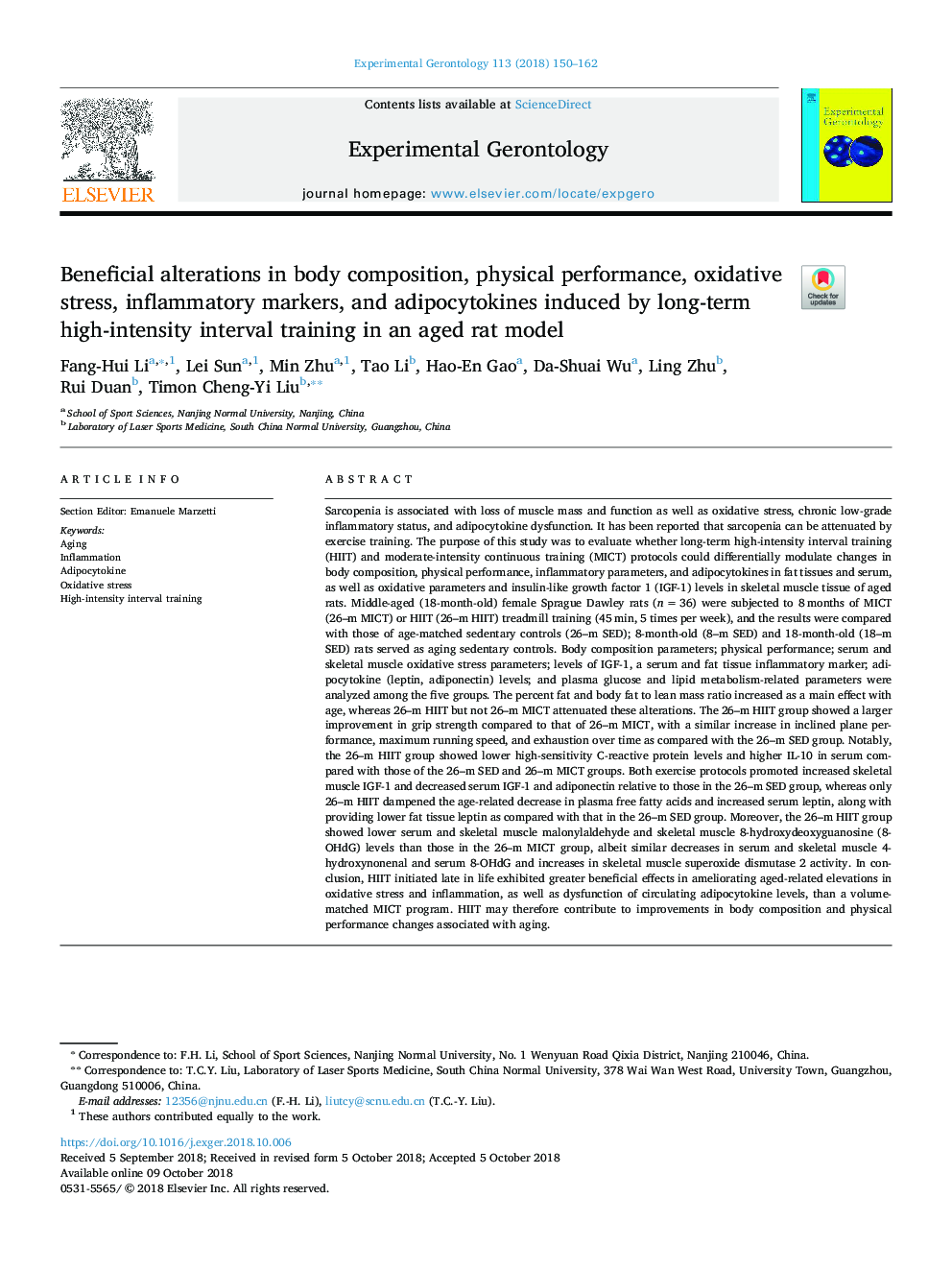| کد مقاله | کد نشریه | سال انتشار | مقاله انگلیسی | نسخه تمام متن |
|---|---|---|---|---|
| 11026208 | 1666413 | 2018 | 13 صفحه PDF | دانلود رایگان |
عنوان انگلیسی مقاله ISI
Beneficial alterations in body composition, physical performance, oxidative stress, inflammatory markers, and adipocytokines induced by long-term high-intensity interval training in an aged rat model
ترجمه فارسی عنوان
تغییرات مفید در ترکیب بدن، عملکرد فیزیکی، استرس اکسیداتیو، نشانگرهای التهابی و آدیپوتیوکوئین ها ناشی از تمرین طولانی مدت تمرین پرش با شدت در مدل موش های سالم
دانلود مقاله + سفارش ترجمه
دانلود مقاله ISI انگلیسی
رایگان برای ایرانیان
کلمات کلیدی
سالخورده، التهاب آدیپوسیتوکین، استرس اکسیداتیو، تمرینات شدید با شدت زیاد،
موضوعات مرتبط
علوم زیستی و بیوفناوری
بیوشیمی، ژنتیک و زیست شناسی مولکولی
سالمندی
چکیده انگلیسی
Sarcopenia is associated with loss of muscle mass and function as well as oxidative stress, chronic low-grade inflammatory status, and adipocytokine dysfunction. It has been reported that sarcopenia can be attenuated by exercise training. The purpose of this study was to evaluate whether long-term high-intensity interval training (HIIT) and moderate-intensity continuous training (MICT) protocols could differentially modulate changes in body composition, physical performance, inflammatory parameters, and adipocytokines in fat tissues and serum, as well as oxidative parameters and insulin-like growth factor 1 (IGF-1) levels in skeletal muscle tissue of aged rats. Middle-aged (18-month-old) female Sprague Dawley rats (nâ¯=â¯36) were subjected to 8â¯months of MICT (26-m MICT) or HIIT (26-m HIIT) treadmill training (45â¯min, 5 times per week), and the results were compared with those of age-matched sedentary controls (26-m SED); 8-month-old (8-m SED) and 18-month-old (18-m SED) rats served as aging sedentary controls. Body composition parameters; physical performance; serum and skeletal muscle oxidative stress parameters; levels of IGF-1, a serum and fat tissue inflammatory marker; adipocytokine (leptin, adiponectin) levels; and plasma glucose and lipid metabolism-related parameters were analyzed among the five groups. The percent fat and body fat to lean mass ratio increased as a main effect with age, whereas 26-m HIIT but not 26-m MICT attenuated these alterations. The 26-m HIIT group showed a larger improvement in grip strength compared to that of 26-m MICT, with a similar increase in inclined plane performance, maximum running speed, and exhaustion over time as compared with the 26-m SED group. Notably, the 26-m HIIT group showed lower high-sensitivity C-reactive protein levels and higher IL-10 in serum compared with those of the 26-m SED and 26-m MICT groups. Both exercise protocols promoted increased skeletal muscle IGF-1 and decreased serum IGF-1 and adiponectin relative to those in the 26-m SED group, whereas only 26-m HIIT dampened the age-related decrease in plasma free fatty acids and increased serum leptin, along with providing lower fat tissue leptin as compared with that in the 26-m SED group. Moreover, the 26-m HIIT group showed lower serum and skeletal muscle malonylaldehyde and skeletal muscle 8-hydroxydeoxyguanosine (8-OHdG) levels than those in the 26-m MICT group, albeit similar decreases in serum and skeletal muscle 4-hydroxynonenal and serum 8-OHdG and increases in skeletal muscle superoxide dismutase 2 activity. In conclusion, HIIT initiated late in life exhibited greater beneficial effects in ameliorating aged-related elevations in oxidative stress and inflammation, as well as dysfunction of circulating adipocytokine levels, than a volume-matched MICT program. HIIT may therefore contribute to improvements in body composition and physical performance changes associated with aging.
ناشر
Database: Elsevier - ScienceDirect (ساینس دایرکت)
Journal: Experimental Gerontology - Volume 113, November 2018, Pages 150-162
Journal: Experimental Gerontology - Volume 113, November 2018, Pages 150-162
نویسندگان
Fang-Hui Li, Lei Sun, Min Zhu, Tao Li, Hao-En Gao, Da-Shuai Wu, Ling Zhu, Rui Duan, Timon Cheng-Yi Liu,
